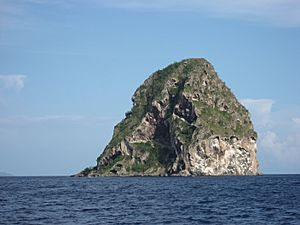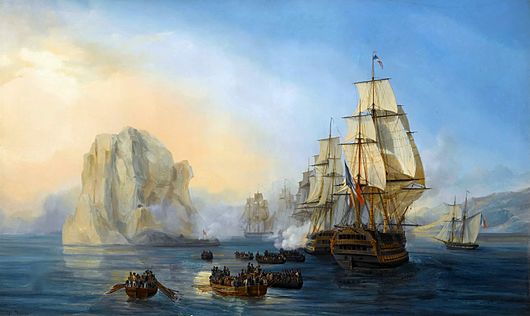Diamond Rock facts for kids

View of Diamond Rock from the west
|
|
| Geography | |
|---|---|
| Location | Martinique |
| Coordinates | 14°26′36″N 61°2′21″W / 14.44333°N 61.03917°W |
| Administration | |
Diamond Rock (called rocher du Diamant in French) is a tall, rocky island that stands 175 meters (574 feet) high. It's made of basalt, a type of volcanic rock. You can find it south of "Grande Anse du Diamant" near Fort-de-France, which is the main port of the Caribbean island of Martinique. This uninhabited island is about 3 kilometers (1.9 miles) from Pointe Diamant.
The island got its name because its sides reflect the sunlight at certain times of the day. This makes it sparkle like a precious jewel, just like a diamond! It's famous for a special reason: the British Empire's Royal Navy once used it as a "ship" called HMS Diamond Rock. This "stone frigate" (a fort on a rock acting like a ship) was active from February 1804 to June 1805 during the Napoleonic Wars. The First French Empire then captured the rock in the Battle of Diamond Rock. The British took it back in 1809 during the invasion of Martinique. Diamond Rock was given back to French control in 1815 and is still part of Martinique today.
Contents
Diamond Rock: A Fort and a "Ship"
Diamond Rock is in a very important spot at the northern end of the Saint Lucia Channel. Being in charge of the rock meant controlling ships moving between Martinique and its neighbor, Saint Lucia.
In September 1803, Commodore Sir Samuel Hood of the British Royal Navy arrived at the rock. He was on his ship, Centaur. Hood's job was to block the bays at Fort Royal and Saint Pierre, Martinique.
Hood decided to turn the rock into a strong British outpost. He sent his men to climb the rock and set up cannons. It was a huge effort! They used ropes and pulleys to pull two 18-pounder cannons all the way to the very top. The British quickly built defenses and brought in food and water for a group of 120 men. This group was led by Lieutenant James Wilkes Maurice.
Commodore Hood officially named the island "HMS Diamond Rock". Even though it was a rock, it was treated like a sloop (a type of warship). This is why it's called a "stone frigate". Lieutenant Maurice, who did a great job setting up the fort, was made its commander. One 24-pounder cannon was placed in a cave halfway up the rock and named "Hood Battery" after the Commodore. Other cannons were placed at the base of the rock to protect the only landing spot.
Life on the rock was tough. The soldiers slept in caves, and officers used tents. Supplies were pulled up using ropes and pulleys. To help with food, the soldiers kept goats, chickens, and guinea hens. There was also a hospital in a cave at the bottom of the rock for sick or injured sailors.
One night, some local people secretly visited the rock. They brought fruits and bananas to trade. They also warned the British that a French engineer was planning to set up cannons to attack the rock. One of the locals, who used to work for an English owner, asked for protection. Commodore Hood agreed and sent a small group of soldiers with him. They captured the French engineer and some soldiers, stopping the attack before it could even begin!
For 17 months, the fort on Diamond Rock was a big problem for French ships. Its cannons could fire far out to sea, forcing ships to go around it. This made it very hard for French ships to reach Fort Royal. The French tried many times to take the rock back, but they always failed.
The Battle for Diamond Rock
In 1805, French Admiral Villeneuve was ordered by Napoleon to recapture Diamond Rock. A large French and Spanish fleet of 16 ships, led by French Captain Cosmao-Kerjulien, surrounded the rock. From May 16 to May 29, the French fleet completely blocked off the rock.
The actual attack happened on May 31. The French managed to land some troops on the rock. Lieutenant Maurice had expected this and moved his men to higher, more defensible positions. The British fire trapped the French landing party in caves near the sea.
However, the British garrison faced a big problem: their stone water tank had cracked, possibly due to an earthquake. They were running out of water and also low on ammunition. After a fierce fight, Lieutenant Maurice had to surrender to the much larger French force on June 3, 1805. He had held out against two large French ships, a frigate, a corvette, a schooner, and eleven gunboats.
The British lost two men, and the French lost about 20 to 50 men. The French took the 107 British soldiers as prisoners. They were later sent back to Barbados. Lieutenant Maurice was praised for his brave defense of the rock.
The rock stayed in French hands until 1809, when the British recaptured it during the invasion of Martinique. When Martinique was given back to France in 1815, Diamond Rock went with it. It has been French ever since.
Diamond Rock in Stories
The exciting story of Diamond Rock has inspired writers. There's an old poem called "The Diamond Rock" about the event.
Two authors, "Sea Lion" (whose real name was Geoffrey Bennett) and Dudley Pope, also wrote novels based on the 1804 events. Bennett's book was called The Diamond Rock (1950), and Pope's was Ramage's Diamond (1976).
Nature on Diamond Rock
Diamond Rock is actually a volcanic plug. This means it's the leftover core of a very old volcano that was active about a million years ago.
The rock has its own special nature. It's sunnier and drier than the main island of Martinique. Today, it's covered in small plants and cacti.
Because it's hard to reach and no one lives there, the island has become a safe place for wildlife. Scientists believe Diamond Rock might be the last home for a type of reptile called the couresse grass snake (Liophis cursor). This snake used to live all over Martinique but hasn't been seen on the main island since 1962. It's now thought to be extinct everywhere else.
Important Bird Area
Diamond Rock is also recognized as an Important Bird Area (IBA) by BirdLife International. This is because it's a breeding ground for many seabirds, including brown boobies, brown noddies, and bridled terns.
Diving Around the Island
Below the water, Diamond Rock has a deep, triangular cave that is very popular with scuba divers. This cave is said to be full of beautiful sea fans and corals. However, strong currents around the island can make diving a bit risky.
Divers have even reported finding one of the rock's old cannons underwater. It was likely toppled from the summit by the French during the battle.




